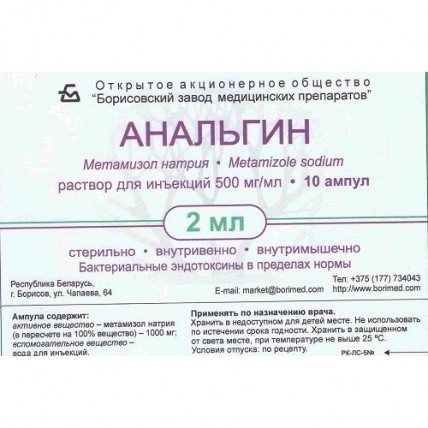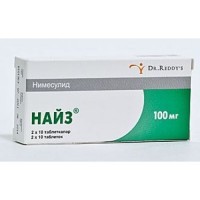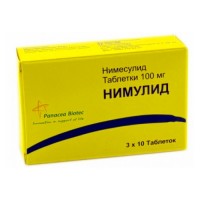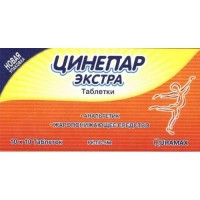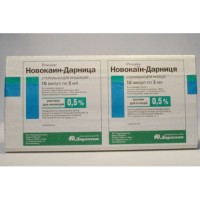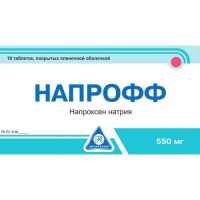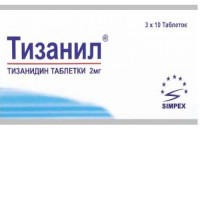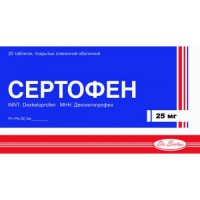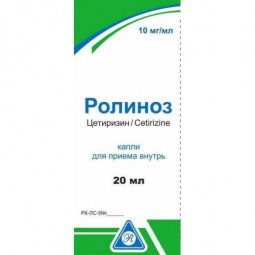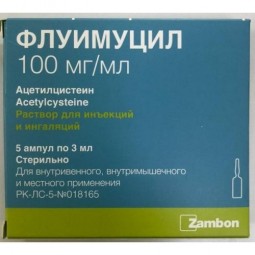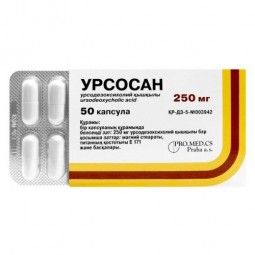Analgin 50% / 2 ml 10s solution for injection in ampoules
- $3.10
The instruction for medical use
of ANALGINUM medicine
the Trade name
Analginum
the International unlicensed
name Metamizole Sodium Dosage Form Solution for injections of 500 mg/ml
One ampoule (2 ml) contains Structure:
active agent – metamizole sodium (in terms of 100% substance) - 1000 mg,
excipient – water for injections.
Description
Transparent liquid of yellowish color.
Pharmacotherapeutic group
Analgetics-antipyretics others. Pyrazyl ketones.
The ATX N02BB02 code
the Pharmacological
Pharmacokinetics Later properties of intramuscular introduction is quickly absorbed and comes to a liver where 4 methylaminoantipyrines (4-MAA) are exposed to hydrolysis with formation of an active metabolite and demetilirutsya to the second active metabolite – 4 aminoantipyrines (4-AA) and also biotransformirutsya to inactive metabolites – 4 formylaminoantipyrines (4-FAA) and 4 of acetylaminoantipyrine (4-AcAA). Not changed analginum is found in blood in insignificant quantities only after intravenous administration. In blood reversibly contacts proteins of blood plasma (4-MAA for 58%, 4-AA for 48%). Effective concentration of the sum of metabolites of analginum makes 10 mkg/ml. Toxic action is shown at concentration of metabolites over 20 mkg/ml. At repeated administration of drug its pharmacokinetics does not change. Cumulation of drug is not noted.
The general system clearance of active metabolites 4-MAA and 4-AA is 182.9±15.1 ml/min. and 55.2±6.4 ml/min. respectively. The period of their semi-elimination (T½) is 2.5-3.0 h and 6-8 h respectively. It is removed in the form of metabolites with urine.
At patients with a renal failure at observance of the recommended mode of dosing of cumulation of invariable active agent it is not noted.
A pharmacodynamics
Analginum - the means of nonsteroid structure rendering analgeziruyushchy, febrifugal and mild anti-inflammatory action.
The mechanism of action is connected with inhibition of activity of cyclooxygenase I and II of types. Reactions of an arachidonic cascade of synthesis of eicosanoids are as a result blocked and formation of prostaglandins PgE2, PgF2a, their endoperoxides, bradykinin is broken. In kernels of an anti-nociceptive system analginum strengthens discharge of kinureninovy acid which slows down carrying out painful impulses (due to influence on NMDA receptors).
Interferes with carrying out painful impulses from extra- and proprioceptive receptors on Gaulle and Burdakh's bunches, raises an excitation threshold of the painful centers of a thalamus. At the same time strengthens a thermolysis, reduces activity of the thermoadjusting center of a hypothalamus.
Indications
- a pain syndrome of weak and average intensity of various origin and
localization (a headache, tooth, disalgomenoreya, neuralgia, myalgias,
pain in an osteoarthrosis, arthritis, injuries, burns, shingles,
tumors, an orchitis, pleurisy, pneumonia, pericarditises, in
backbone diseases (lumbago, a sciatica, osteochondrosis))
- stopping of pain in gripes hepatic, intestinal, renal, in
a lung heart attack, a myocardial infarction, the stratifying aortic aneurysm and fibrinferment
of the main vessels (as a part of complex therapy)
- a feverish syndrome in acute infectious diseases, stings
of insects (mosquitoes, mosquitoes, bees, gadflies)
Apply the Route of administration and doses intramusculary and intravenously (in severe pain).
To adults and teenagers 15 years a single dose are more senior makes 500-1000 mg (1 - 2 ml of 50% of solution) 2-3 times a day. Intravenous administration in the dose exceeding 1000 mg (2 ml) is possible only after careful specification of indications. Maximum single dose of 2000 mg (4 ml). The maximum daily dose – 2000-3000 mg (4-6 ml of 50% of solution). Duration of use of drug is no more than 3-5 days. Repeated courses of use are possible not earlier than in 1 month.
To children enter 50-250 mg (0.1-0.5 ml of 50% of solution). The daily dose is established depending on body weight. At the body weight of 5-8 kg the daily dose makes 50-100 mg (0.1-0.2 ml of 50% of solution), weighing 9-15 kg – 100-250 mg (0.2-0.5 ml of 50% of solution), weighing 16-23 kg – 150-400 mg (0.3-0.8 ml of 50% of solution), weighing 24-30 kg – 200-500 mg (0.4-1.0 ml of 50% of solution), weighing 31-45 kg – 250-750 mg (0.5-1.5 ml of 50% of solution), weighing 46-53 kg – 400-900 mg (0.8-1.8 ml of 50% of solution). To children till 1 year only intramusculary.
Intravenous administration should be carried out slowly (with a speed no more than 1 ml/min.), in position of the patient lying, under control of the ABP, ChSS and breath. Injection solution has to be warmed up up to 37-38 °C.
Drug is intended for short-term use.
Duration of treatment is determined by the attending physician.
Side effects
- an agranulocytosis, a leukopenia, thrombocytopenia
- the hypotonia which is not connected with hypersensitivity reactions
- oligo- or an anury, a proteinuria, interstitial nephrite
- skin allergic reactions, a small tortoiseshell, a multiformny exudative erythema (Stephens-Johnson's syndrome), a toxic epidermal necrolysis (Lyell's disease), a Quincke's edema
- anaphylactic/anaphylactoid reactions, a bronchospasm
Perhaps
- formation of infiltrate in the injection site (at intramuscular introduction)
- nausea, vomiting, anorexia, stomach aches, a meteorism, constipations
Seldom
- paresthesia, sonitus, a disorder of vision, a tremor, a depression
- an acute anaphylaxis
of the Contraindication
- hypersensitivity to analginum and other derivatives of pyrazyl ketone (to propyphenazone, phenylbutazone, phenazone - to the containing means)
- a sharp hepatic porphyria
- deficit glyukozo-6-fosfatdegidrogenazy
- hemopoiesis oppression (agranulocytosis, a neutropenia)
- heavy abnormal liver functions and/or kidneys
- the attacks of bronchial asthma, urticaria, acute rhinitis connected with use of non-steroidal anti-inflammatory drugs
- existence in the anamnesis of a peptic ulcer of a stomach and a duodenum
- children's age up to 3 months
- pregnancy, feeding by a breast
Medicinal interactions
At simultaneous use with other analgetics-antipyretics and non-steroidal anti-inflammatory drugs perhaps mutual strengthening of toxic effects.
Effect of analginum amplifies at combined use with barbiturates, codeine, H2 blockers of histamine receptors, anapriliny.
Increases risk of development of a leukopenia at combined use with Thiamazolum and cytostatic means.
Analginum forces out oral sugar-lowering means from communication with protein and increases their effect.
Enhances activity of indirect anticoagulants, glucocorticosteroids and indometacin.
Analginum enhances sedation of alcohol.
Analginum lowers concentration of cyclosporine A in blood plasma.
At simultaneous use with derivatives of a fenotiazin the development of the expressed hyperthermia is possible, with sedative means, anxiolytics - analgeziruyushchy effect of analginum amplifies, with caffeine - effect of analginum amplifies.
At use of analginum in a combination from a pitofenon a fenpiveriniya bromide - mutual strengthening of their pharmacological action happens a hydrochloride and with that is followed by reduction of a pain syndrome, relaxation of unstriated muscles and decrease in the increased body temperature.
Tricyclic antidepressants, the combined oral contraceptives and Allopyrinolum slow down metabolism of analginum and increase its toxicity.
At simultaneous use with myotropic spasmolysants (Drotaverinum, a papaverine, pitofenon) and the m-holinoblokatorami (Platyphyllinum, atropine) is observed mutual strengthening of analgeziruyushchy, spasmolytic and febrifugal activity of this combination.
Special instructions
Prolonged use of analginum
In need of regular use of analginum over 5 days it is necessary to control a pattern of peripheral blood weekly.
The acute pain in a stomach
is not recommended use of analginum for stopping of an acute pain in a stomach before clarification of its reason.
Use at persons with pathology of a cardiovascular system
the careful control of pressure, especially at patients with the level of systolic pressure below 100 mm Hg., diseases of kidneys in the anamnesis (pyelonephritis and a glomerulonephritis) and also at persons with alcohol addiction Is necessary.
Removal with urine of products of biotransformation of analginum can cause red coloring of urine which disappears after drug withdrawal.
An agranulocytosis
in case of deterioration in the general condition of the patient against the background of the treatment by analginum which is shown temperature increase, inflammation of mucous membranes of a mouth and throat (necrotic stomatitis, it is purulent - a necrotic tonsillitis), a nose (antritis), increase in SOE, intake of analginum it is necessary
to stop immediately since these symptoms can be connected with development of an agranulocytosis.
The feature of influence of medicine on ability to run motor transport and potentially dangerous mechanisms
needs to be careful at control of motor transport or other mechanisms demanding the increased concentration of attention.
Overdose
Symptoms: vomiting, hypothermia, arterial hypotonia, heartbeat, asthma, drowsiness, confusion of consciousness and nonsense, abnormal liver function and kidneys, spasms, acute renal and liver failure, paralysis of a respiratory system.
Treatment: drug withdrawal. The artificial diuresis and alkalization of urine by introduction of Natrii hydrocarbonas accelerate analginum removal. Carry out the supporting and symptomatic therapy directed to elimination of the arisen disturbances. Specific antidote does not exist.
A form of release and packing
On 2 ml in ampoules from glass.
On each ampoule the text is applied with method of an intaglio printing the fast-fixed paint or paste the label from paper for the polichromatic press or paper offset, or the label self-adhesive.
On 10 ampoules together with a knife or the scarificator for opening of ampoules place in a box of cardboard, the pasted-over label parcel post, with a corrugated insert from paper for corrugation.
Boxes together with iinstruktion on medical use in the state and Russian languages place in a group container.
Or on 10 ampoules in blister strip packaging from a film polyvinylchloride together with a knife or the scarificator for opening of ampoules and the instruction for medical use in the state and Russian languages put in a pack from cardboard.
In case of use of ampoules with a ring of a break or a notch and a point of a break, the investment of a knife or the scarificator for opening of ampoules is not provided.
To Store storage conditions in the place protected from light, at a temperature not above 25ºС.
To store out of children's reach!
3 years
not to use a period of storage after an expiration date.
To Develop prescription status According to the prescription
of ANALGINUM medicine
the Trade name
Analginum
the International unlicensed
name Metamizole Sodium Dosage Form Solution for injections of 500 mg/ml
One ampoule (2 ml) contains Structure:
active agent – metamizole sodium (in terms of 100% substance) - 1000 mg,
excipient – water for injections.
Description
Transparent liquid of yellowish color.
Pharmacotherapeutic group
Analgetics-antipyretics others. Pyrazyl ketones.
The ATX N02BB02 code
the Pharmacological
Pharmacokinetics Later properties of intramuscular introduction is quickly absorbed and comes to a liver where 4 methylaminoantipyrines (4-MAA) are exposed to hydrolysis with formation of an active metabolite and demetilirutsya to the second active metabolite – 4 aminoantipyrines (4-AA) and also biotransformirutsya to inactive metabolites – 4 formylaminoantipyrines (4-FAA) and 4 of acetylaminoantipyrine (4-AcAA). Not changed analginum is found in blood in insignificant quantities only after intravenous administration. In blood reversibly contacts proteins of blood plasma (4-MAA for 58%, 4-AA for 48%). Effective concentration of the sum of metabolites of analginum makes 10 mkg/ml. Toxic action is shown at concentration of metabolites over 20 mkg/ml. At repeated administration of drug its pharmacokinetics does not change. Cumulation of drug is not noted.
The general system clearance of active metabolites 4-MAA and 4-AA is 182.9±15.1 ml/min. and 55.2±6.4 ml/min. respectively. The period of their semi-elimination (T½) is 2.5-3.0 h and 6-8 h respectively. It is removed in the form of metabolites with urine.
At patients with a renal failure at observance of the recommended mode of dosing of cumulation of invariable active agent it is not noted.
A pharmacodynamics
Analginum - the means of nonsteroid structure rendering analgeziruyushchy, febrifugal and mild anti-inflammatory action.
The mechanism of action is connected with inhibition of activity of cyclooxygenase I and II of types. Reactions of an arachidonic cascade of synthesis of eicosanoids are as a result blocked and formation of prostaglandins PgE2, PgF2a, their endoperoxides, bradykinin is broken. In kernels of an anti-nociceptive system analginum strengthens discharge of kinureninovy acid which slows down carrying out painful impulses (due to influence on NMDA receptors).
Interferes with carrying out painful impulses from extra- and proprioceptive receptors on Gaulle and Burdakh's bunches, raises an excitation threshold of the painful centers of a thalamus. At the same time strengthens a thermolysis, reduces activity of the thermoadjusting center of a hypothalamus.
Indications
- a pain syndrome of weak and average intensity of various origin and
localization (a headache, tooth, disalgomenoreya, neuralgia, myalgias,
pain in an osteoarthrosis, arthritis, injuries, burns, shingles,
tumors, an orchitis, pleurisy, pneumonia, pericarditises, in
backbone diseases (lumbago, a sciatica, osteochondrosis))
- stopping of pain in gripes hepatic, intestinal, renal, in
a lung heart attack, a myocardial infarction, the stratifying aortic aneurysm and fibrinferment
of the main vessels (as a part of complex therapy)
- a feverish syndrome in acute infectious diseases, stings
of insects (mosquitoes, mosquitoes, bees, gadflies)
Apply the Route of administration and doses intramusculary and intravenously (in severe pain).
To adults and teenagers 15 years a single dose are more senior makes 500-1000 mg (1 - 2 ml of 50% of solution) 2-3 times a day. Intravenous administration in the dose exceeding 1000 mg (2 ml) is possible only after careful specification of indications. Maximum single dose of 2000 mg (4 ml). The maximum daily dose – 2000-3000 mg (4-6 ml of 50% of solution). Duration of use of drug is no more than 3-5 days. Repeated courses of use are possible not earlier than in 1 month.
To children enter 50-250 mg (0.1-0.5 ml of 50% of solution). The daily dose is established depending on body weight. At the body weight of 5-8 kg the daily dose makes 50-100 mg (0.1-0.2 ml of 50% of solution), weighing 9-15 kg – 100-250 mg (0.2-0.5 ml of 50% of solution), weighing 16-23 kg – 150-400 mg (0.3-0.8 ml of 50% of solution), weighing 24-30 kg – 200-500 mg (0.4-1.0 ml of 50% of solution), weighing 31-45 kg – 250-750 mg (0.5-1.5 ml of 50% of solution), weighing 46-53 kg – 400-900 mg (0.8-1.8 ml of 50% of solution). To children till 1 year only intramusculary.
Intravenous administration should be carried out slowly (with a speed no more than 1 ml/min.), in position of the patient lying, under control of the ABP, ChSS and breath. Injection solution has to be warmed up up to 37-38 °C.
Drug is intended for short-term use.
Duration of treatment is determined by the attending physician.
Side effects
- an agranulocytosis, a leukopenia, thrombocytopenia
- the hypotonia which is not connected with hypersensitivity reactions
- oligo- or an anury, a proteinuria, interstitial nephrite
- skin allergic reactions, a small tortoiseshell, a multiformny exudative erythema (Stephens-Johnson's syndrome), a toxic epidermal necrolysis (Lyell's disease), a Quincke's edema
- anaphylactic/anaphylactoid reactions, a bronchospasm
Perhaps
- formation of infiltrate in the injection site (at intramuscular introduction)
- nausea, vomiting, anorexia, stomach aches, a meteorism, constipations
Seldom
- paresthesia, sonitus, a disorder of vision, a tremor, a depression
- an acute anaphylaxis
of the Contraindication
- hypersensitivity to analginum and other derivatives of pyrazyl ketone (to propyphenazone, phenylbutazone, phenazone - to the containing means)
- a sharp hepatic porphyria
- deficit glyukozo-6-fosfatdegidrogenazy
- hemopoiesis oppression (agranulocytosis, a neutropenia)
- heavy abnormal liver functions and/or kidneys
- the attacks of bronchial asthma, urticaria, acute rhinitis connected with use of non-steroidal anti-inflammatory drugs
- existence in the anamnesis of a peptic ulcer of a stomach and a duodenum
- children's age up to 3 months
- pregnancy, feeding by a breast
Medicinal interactions
At simultaneous use with other analgetics-antipyretics and non-steroidal anti-inflammatory drugs perhaps mutual strengthening of toxic effects.
Effect of analginum amplifies at combined use with barbiturates, codeine, H2 blockers of histamine receptors, anapriliny.
Increases risk of development of a leukopenia at combined use with Thiamazolum and cytostatic means.
Analginum forces out oral sugar-lowering means from communication with protein and increases their effect.
Enhances activity of indirect anticoagulants, glucocorticosteroids and indometacin.
Analginum enhances sedation of alcohol.
Analginum lowers concentration of cyclosporine A in blood plasma.
At simultaneous use with derivatives of a fenotiazin the development of the expressed hyperthermia is possible, with sedative means, anxiolytics - analgeziruyushchy effect of analginum amplifies, with caffeine - effect of analginum amplifies.
At use of analginum in a combination from a pitofenon a fenpiveriniya bromide - mutual strengthening of their pharmacological action happens a hydrochloride and with that is followed by reduction of a pain syndrome, relaxation of unstriated muscles and decrease in the increased body temperature.
Tricyclic antidepressants, the combined oral contraceptives and Allopyrinolum slow down metabolism of analginum and increase its toxicity.
At simultaneous use with myotropic spasmolysants (Drotaverinum, a papaverine, pitofenon) and the m-holinoblokatorami (Platyphyllinum, atropine) is observed mutual strengthening of analgeziruyushchy, spasmolytic and febrifugal activity of this combination.
Special instructions
Prolonged use of analginum
In need of regular use of analginum over 5 days it is necessary to control a pattern of peripheral blood weekly.
The acute pain in a stomach
is not recommended use of analginum for stopping of an acute pain in a stomach before clarification of its reason.
Use at persons with pathology of a cardiovascular system
the careful control of pressure, especially at patients with the level of systolic pressure below 100 mm Hg., diseases of kidneys in the anamnesis (pyelonephritis and a glomerulonephritis) and also at persons with alcohol addiction Is necessary.
Removal with urine of products of biotransformation of analginum can cause red coloring of urine which disappears after drug withdrawal.
An agranulocytosis
in case of deterioration in the general condition of the patient against the background of the treatment by analginum which is shown temperature increase, inflammation of mucous membranes of a mouth and throat (necrotic stomatitis, it is purulent - a necrotic tonsillitis), a nose (antritis), increase in SOE, intake of analginum it is necessary
to stop immediately since these symptoms can be connected with development of an agranulocytosis.
The feature of influence of medicine on ability to run motor transport and potentially dangerous mechanisms
needs to be careful at control of motor transport or other mechanisms demanding the increased concentration of attention.
Overdose
Symptoms: vomiting, hypothermia, arterial hypotonia, heartbeat, asthma, drowsiness, confusion of consciousness and nonsense, abnormal liver function and kidneys, spasms, acute renal and liver failure, paralysis of a respiratory system.
Treatment: drug withdrawal. The artificial diuresis and alkalization of urine by introduction of Natrii hydrocarbonas accelerate analginum removal. Carry out the supporting and symptomatic therapy directed to elimination of the arisen disturbances. Specific antidote does not exist.
A form of release and packing
On 2 ml in ampoules from glass.
On each ampoule the text is applied with method of an intaglio printing the fast-fixed paint or paste the label from paper for the polichromatic press or paper offset, or the label self-adhesive.
On 10 ampoules together with a knife or the scarificator for opening of ampoules place in a box of cardboard, the pasted-over label parcel post, with a corrugated insert from paper for corrugation.
Boxes together with iinstruktion on medical use in the state and Russian languages place in a group container.
Or on 10 ampoules in blister strip packaging from a film polyvinylchloride together with a knife or the scarificator for opening of ampoules and the instruction for medical use in the state and Russian languages put in a pack from cardboard.
In case of use of ampoules with a ring of a break or a notch and a point of a break, the investment of a knife or the scarificator for opening of ampoules is not provided.
To Store storage conditions in the place protected from light, at a temperature not above 25ºС.
To store out of children's reach!
3 years
not to use a period of storage after an expiration date.
To Develop prescription status According to the prescription
